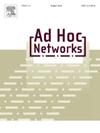5G网络中基于qos的车联网网络切片与资源管理
IF 4.8
3区 计算机科学
Q1 COMPUTER SCIENCE, INFORMATION SYSTEMS
引用次数: 0
摘要
随着车联网(IoV)技术的发展,5G及以后的异构服务质量(QoS) (B5G)等问题也随之而来。这些挑战与频谱稀缺密切相关,频谱稀缺是未来无线技术面临的最大挑战之一。特别是在V2X通信时代,由于信道、带宽和功率等无线电资源的限制,这种情况将会加剧。车辆数量的增加进一步加剧了这一挑战。因此,频谱共享对交通安全和效率有着重要的影响。为了应对这些挑战并满足5G/B5G中车载应用的各种QoS需求,新无线电车对万物(NR-V2X)和网络切片(NS)等新范式已成为重要的解决方案。网络切片有效地将物理网络划分为针对超可靠低延迟通信(URLLC)、增强型移动宽带(eMBB)和大规模机器类型通信(mMTC)量身定制的切片。在本文中,我们研究了具有QoS支持的IoV切片问题,重点关注将物理网络划分为三个不同的切片:URLLC, eMBB和mMTC。为了确保车辆网络中的无缝通信,我们的混合方法有效地结合了移交机制、紧急交通优先级、基于服务和道路网络特定参数。此外,我们提出了两种资源分配算法,能够有效地将资源分配给车辆,并符合第三代合作伙伴计划(3GPP)的标准化原则。这些算法旨在确定事故期间紧急流量的优先级,同时在资源受限的环境中为非安全服务保持可接受的QoS,从而提高关键性能指标(kpi)。详细的仿真显示了所提出算法的有效性,并证实了它们在确保可接受的可靠性和吞吐量的同时,在端到端延迟方面提高应急服务性能的能力。对比评价进一步突出了所提出的NS方法相对于其他现有方法的优越性。本文章由计算机程序翻译,如有差异,请以英文原文为准。
QoS-aware Network Slicing and Resource Management for Internet of Vehicles in 5G networks
The development of Internet of Vehicles (IoV) technologies brings with it numerous challenges, such as heterogeneous Quality of Service (QoS) in 5G and beyond (B5G). These challenges go hand in hand with spectrum scarcity, one of the biggest challenges of future wireless technologies. This will be exacerbated especially in the era of Vehicle-to-Everything (V2X) communication due to the limitation of radio resources such as channels, bandwidth, and power. This challenge is further intensified by the increasing number of vehicles. Therefore, spectrum sharing initiatives have a significant impact on traffic safety and efficiency. In response to these challenges and to meet the diverse QoS requirements of vehicular applications within 5G/B5G, new paradigms such as New Radio Vehicle-to-Everything (NR-V2X) and Network Slicing (NS) have emerged as important solutions. Network Slicing efficiently divides the physical network into slices tailored to Ultra-Reliable Low Latency Communications (URLLC), Enhanced Mobile Broadband (eMBB) and massive Machine Type Communications (mMTC). In this paper, we investigate the IoV slicing problem with QoS support, focusing on partitioning the physical network into three different slices: URLLC, eMBB and mMTC. To ensure seamless communication in vehicular networks, our mixed method approach effectively incorporates handover mechanisms, emergency traffic prioritization, based services, and road network-specific parameters. In addition, we propose two resource allocation algorithms that enable efficient allocation of resources to vehicles and comply with the standardization principles of the 3rd Generation Partnership Project (3GPP). These algorithms aim to prioritize emergency traffic during incidents while maintaining an acceptable QoS for non-safety services in a resource-constrained environment, thus improving Key Performance Indicators (KPIs). Detailed simulations show the effectiveness of the proposed algorithms, and confirm their ability to improve the performance of emergency services in terms of end-to-end delay while ensuring acceptable reliability and throughput. Comparative evaluations further highlight the superiority of the proposed NS method over other existing approaches.
求助全文
通过发布文献求助,成功后即可免费获取论文全文。
去求助
来源期刊

Ad Hoc Networks
工程技术-电信学
CiteScore
10.20
自引率
4.20%
发文量
131
审稿时长
4.8 months
期刊介绍:
The Ad Hoc Networks is an international and archival journal providing a publication vehicle for complete coverage of all topics of interest to those involved in ad hoc and sensor networking areas. The Ad Hoc Networks considers original, high quality and unpublished contributions addressing all aspects of ad hoc and sensor networks. Specific areas of interest include, but are not limited to:
Mobile and Wireless Ad Hoc Networks
Sensor Networks
Wireless Local and Personal Area Networks
Home Networks
Ad Hoc Networks of Autonomous Intelligent Systems
Novel Architectures for Ad Hoc and Sensor Networks
Self-organizing Network Architectures and Protocols
Transport Layer Protocols
Routing protocols (unicast, multicast, geocast, etc.)
Media Access Control Techniques
Error Control Schemes
Power-Aware, Low-Power and Energy-Efficient Designs
Synchronization and Scheduling Issues
Mobility Management
Mobility-Tolerant Communication Protocols
Location Tracking and Location-based Services
Resource and Information Management
Security and Fault-Tolerance Issues
Hardware and Software Platforms, Systems, and Testbeds
Experimental and Prototype Results
Quality-of-Service Issues
Cross-Layer Interactions
Scalability Issues
Performance Analysis and Simulation of Protocols.
 求助内容:
求助内容: 应助结果提醒方式:
应助结果提醒方式:


